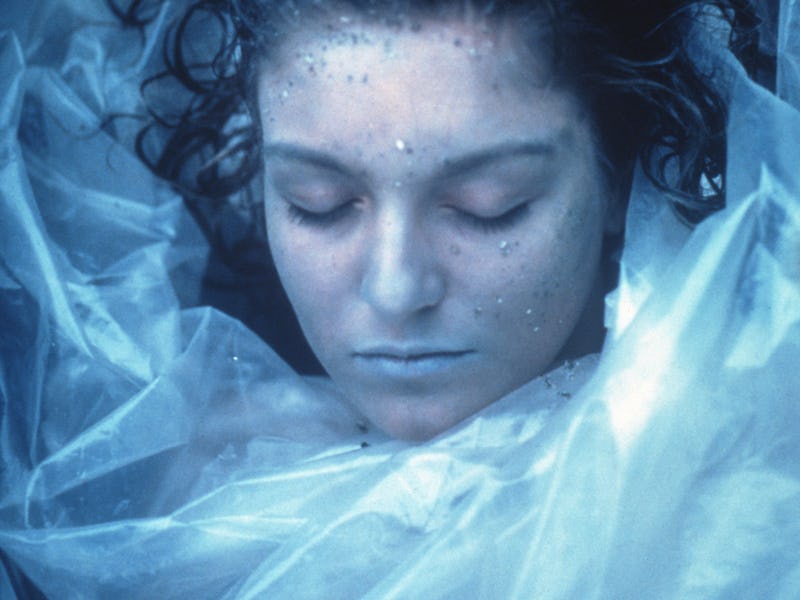Everything We Need to Know About Twin Peaks Is In Its Pilot
Thirty-five years later, the Twin Peaks pilot is still the perfect introduction to David Lynch's strange, sad world.

Around halfway through the Twin Peaks pilot — which aired 35 years ago over a two-hour time slot on ABC — Special Agent Dale Cooper (Kyle Maclachlan) is lent over a mortuary slab, prying something from underneath the fingernail of Laura Palmer (Sheryl Lee), the 17-year-old prom queen whose body just washed up on a riverbank in small Washington town Twin Peaks. Cooper has been called in after a second young woman was found alive with similar wounds nearby; he believes both crimes have something to do with an ongoing case. There is a piece of paper under Laura’s fingernail, a square too small for anything but the letter “R” on it. Cooper is delighted — his inappropriate grin is lit up by a flickering fluorescent light above the table, giving the intimate scene the feeling of Frankenstein’s lab. For local sheriff Harry S. Truman (Michael Ontkean), sat on Laura’s other side, his investigation just took a detour into eerier, confounding territory.
For new Twin Peaks initiates who have maybe only seen Dale Cooper through viral clips — like his love of a good brew and sweet treats, his willingness to treat himself, or his brief altercation with a llama — his more hard-edged, macabre characterization in the Twin Peaks pilot can be a little off-putting. While it’s common for fans who rewatch their favorite series from the very beginning to react to how unpolished and brusque the main characters can be before years of refinement and development (hello, any Star Trek spinoff ensemble), Twin Peaks only had 30 episodes to let its characters evolve and change, and Cooper has decidedly become his empathetic and quirky self by time of Laura’s funeral in Episode 4.
But while the mood of the Twin Peaks pilot, which was shown at Telluride Film Festival seven months before its TV broadcast, is faithful to the melancholy, unnerving, and amusing blend of soap theatrics and mystery plotting that would define the show’s initial 1990s run, the pilot takes advantage of its extended runtime to give us as full a portrait of the emotional extremes and patient filmic language that distinguished Twin Peaks from any other show on television. The pilot had to set up the main plot and demonstrate how we would explore it in ways unorthodox for contemporary TV.
Special Agent Dale Cooper makes his way to Twin Peaks.
Laura Palmer’s demise haunts her friends and peers before they’re given the heartbreaking announcement. Her quiet best friend Donna (Lara Flynn Boyle) sits in class, wondering why Laura hasn’t shown up for school, when a solemn police officer interrupts the roll call. Before he or the teacher can address the class, a scream breaks the silence and we catch a sight of a female pupil tearing it across the yard. First with the responding officers, then with Laura’s parents, now with her classmates, the revelation of Laura’s murder is a recurring trauma, fracturing the supposed peace of Twin Peaks with the same intensity throughout the pilot episode.
So much of the pilot is interested in the immediate shock of teenage grief (and the adults struggling to cope with a symbol of innocence shattered) that director David Lynch and co-writer Mark Frost overwhelm us, engulfing the eccentric character interludes with Lynch’s brand of heightened, but cutting, sadness — before yanking us towards chilling hints at the darkness we know must have claimed Laura. It’s as if we were the flashlights beams only able to see a circle’s worth of light in the town’s thick, sinister forest.
Laura Palmer’s friends mourn her throughout the pilot.
What makes the Twin Peaks pilot so rewatchable (in a way that the later episodes in Season 2 aren’t) is how much it delights in cracking open a mystery and letting the pain and confusion spill out, Pandora’s Box style. Even in a format as digestible and audience-friendly as network television, you can tell Lynch’s priority was to establish a strange but familiar place and see how it would react to absorbing such this pain. It’s telling that the 90 minute pilot, with its eye-catching symbols and delicious open-ended questions, is a far more satisfying experience than the international TV movie version, which added footage that wrapped up the mystery — Lynch is so committed to the texture and sadness of being left in the lurch by forces greater than ourselves, that we feel better fed by a more evocative and unresolved version of the story.
The Twin Peaks pilot may not be self-contained, but is the rich sample from which the ensuing series would borrow and extrapolate from until it prematurely ended after Season 2. The David Lynch film that has most in common with the pilot is his magnum opus Mulholland Dr., which began as a 90 minute pilot for ABC that was never picked up, and then retooled as a feature film with additional footage that questioned the reality of everything we had just seen. Both Twin Peaks and Mulholland Dr. thrive off the titillation and emotional weight of posing problems that couldn’t be resolved through simple, satisfying narrative — and both projects had to course correct when ABC disapproved of their ambitions. Thirty-five years on, Twin Peaks gave us as perfect a pilot as you could get: Laura Palmer’s demise cracks open a whole world, where every poignant and tense insight was waiting to be coaxed with Lynch’s trademark grace and strangeness into the light.